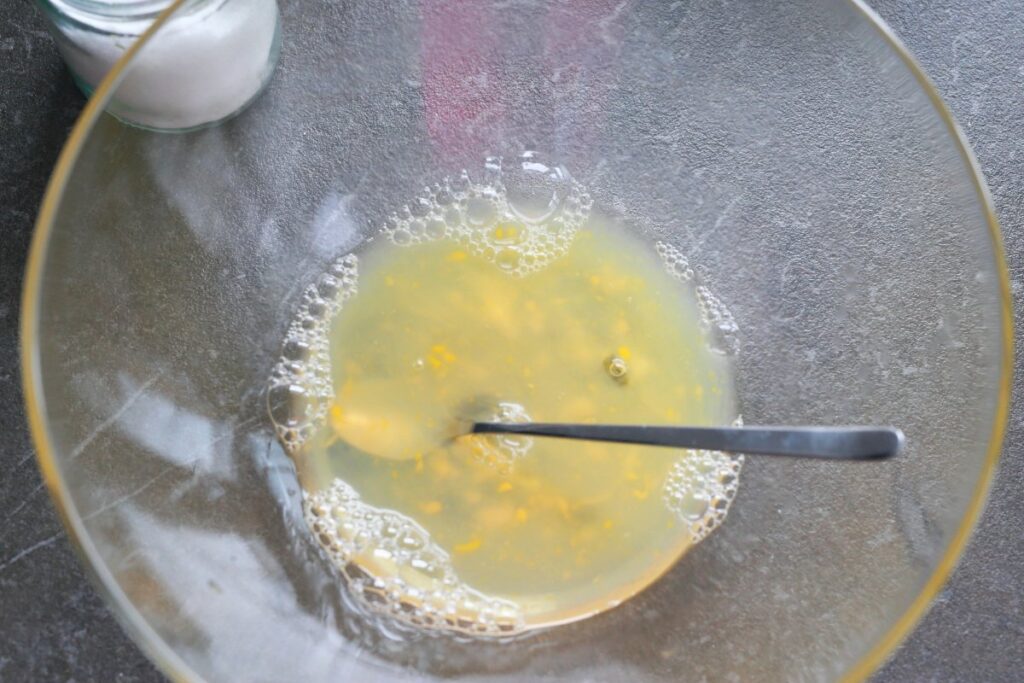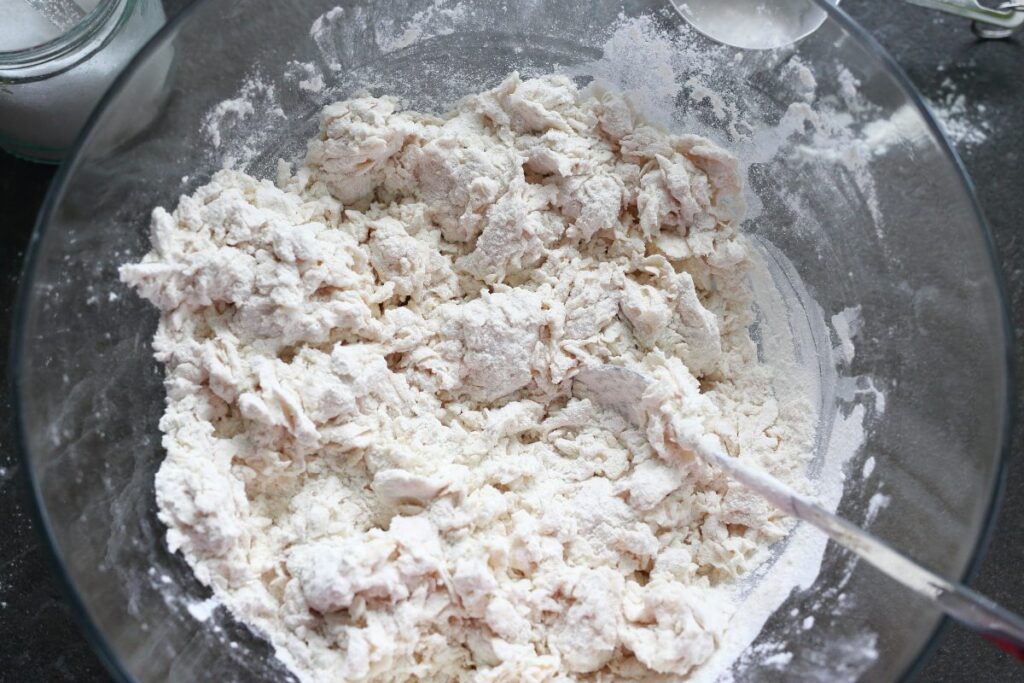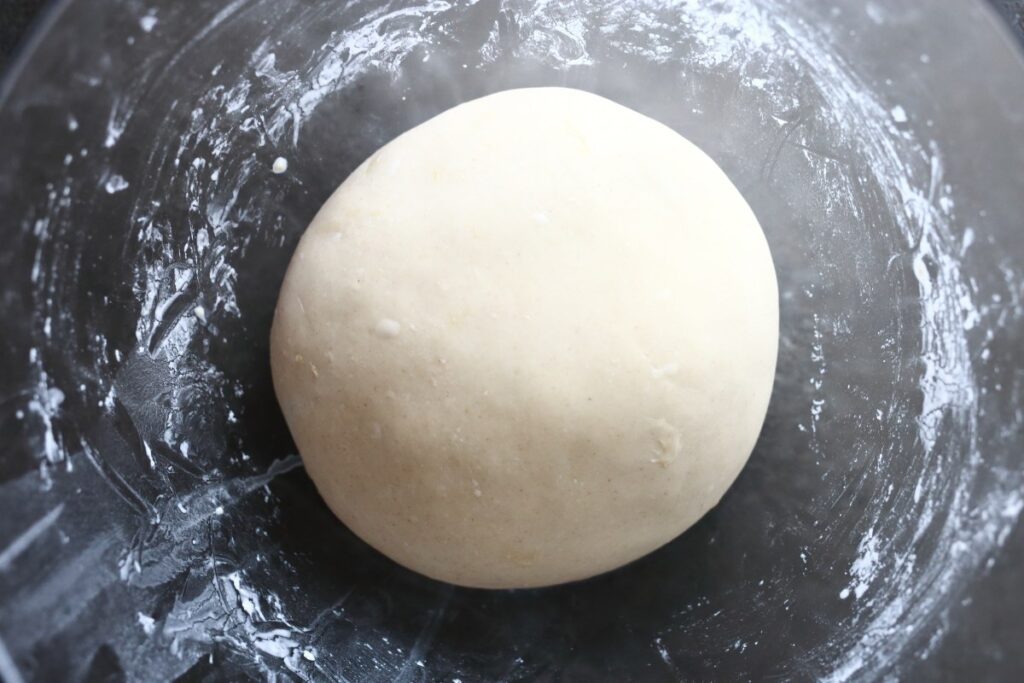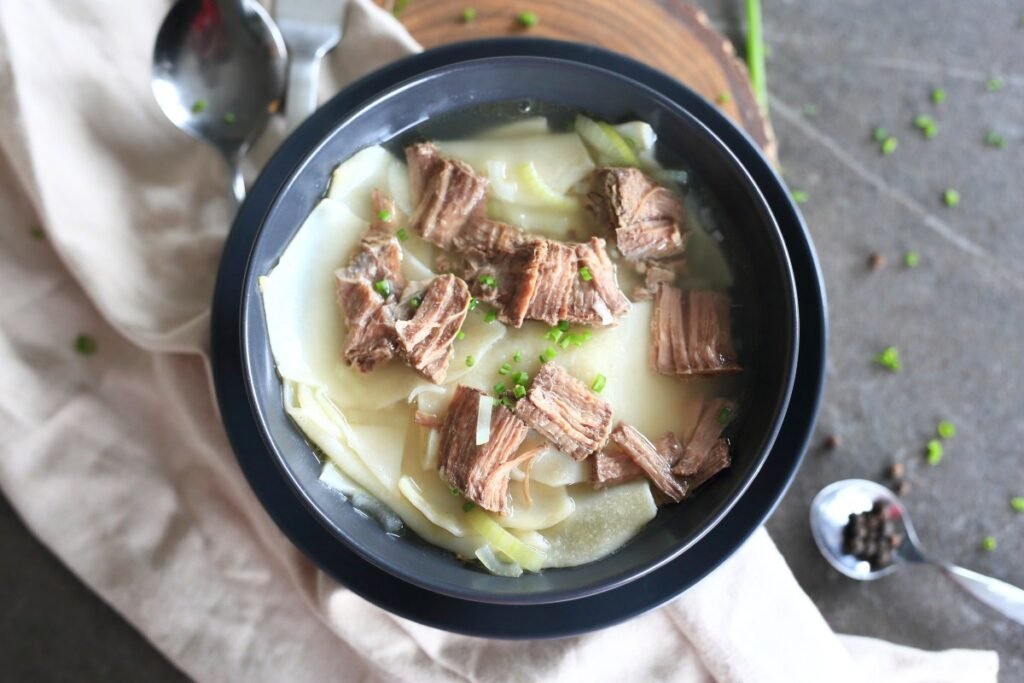Beshbarmak – Kazakh Meat and Noodles (VIDEO)
Beshbarmak is a hearty Kazakh dish made with cooked meat, homemade noodles and freshly-cooked broth. Served with or without broth, this dish is delicious, filling and heart-warming.

Some of the links on this page might be affiliate links. View my Privacy Policy for details.
Being born in Kazakhstan, I grew up eating this dish and love it so much. But I have never made it myself until my husband nagged me often enough to make it (his favorite dish/meal). I finally gave in and now I wonder why it took me so long to make it. I make it on a regular basis now because everyone loves it at our house.
Beshbarmak means “five fingers” and is supposedly an indication of how the dish was traditionally eaten – everyone used their hands to eat the meat and the noodles. The broth was served on the side. Nowadays of course, we use utensils to eat the dish and I prefer to serve the broth poured over the noodles and meat which saves me extra plates to wash.
If you’re a meat lover and would like a hearty, heart-warming dish, definitely make this one!
In this post…
Beshbarmak VIDEO
Here is a quick video to show how I prepare single portions of Beshbarmak once the meat and broth are cooked and the dough is made. All the detailed instructions can also be found below.
Ingredients for Beshbarmak
Beef meat & bones (soup bones and marrow bones) – you really only need to cook the meat, but I like to add bones so that I get a good quality broth and the leftover broth can be used for other things like soups and sauces. Traditionally, Beshbarmak is made from horse meat. Since that is not widely available, good alternatives are beef, lamb, and sometimes even chicken or pork. If you use a different meat, know that the cooking time will be longer or shorter depending on the meat.
Water – for making the broth.
Broth seasonings – Salt, bay leaf, white onion, carrot, celery (or celery root) and black pepper corns.
Dough for the noodles – water, salt, egg, flour.
White/Yellow Onion – to serve with the meat and noodles at the end.
How to Make Beshbarmak
Meat
Add the bones and the meat to a big soup pot, fill with water and bring to a boil. I used frozen meat and bones. No need to thaw beforehand.
OPTIONAL: Once the water comes to a boil, pour it out, fill the pot with fresh water and bring to a boil again. This gets rid of impurities in the meat. But if you want to save time, you can keep cooking with the first pot of water.
Using a slotted spoon or a fine mesh sieve, remove the foamy scum from the water as the meat cooks. Add the salt at this stage as it makes the impurities come out faster.
Once the soup is mostly clear of the scum and is simmering nicely, add the whole onion, carrot, celery, bay leaf, and peppercorn. I don’t add them before that because then I end up taking them out with the sieve when I skim the foam from the soup.
Reduce the heat to low and let the broth simmer for about 3 hours. If you have smaller pieces, the meat might be ready before that. However, in my experience the beef was always tender and soft after 3 hours.



Once the meat is fully cooked, remove from heat, but keep in the broth and covered until ready to serve.
Once ready to serve, remove the meat onto a separate platter and shred into smaller pieces.
Homemade Noodles
I use the same dough in this recipe to make noodles as I do for making Pelmeni (Russian Meat Dumplings). It’s very easy to make.
Add hot water to a big bowl and add salt. Stir so that the salt dissolves.
Allow the water to cool a bit then add the egg (adding the egg to hot water will cook the egg) and stir it up in the water.
Measure out the flour and add to the water and egg mixture. Start with adding a bit less flour (3 1/2 cups) so that your dough is not too dry. Add more as necessary. Knead the dough until a smooth dough ball forms. Let the dough rest for at least 30-40 minutes and it will be easier to work with. I usually let it rest until the meat and broth are ready.



Once ready, cut off smaller pieces of the dough and using a rolling pin, roll them out thinly. Cut the dough into bigger rectangles. They don’t have to be perfect. You can do other shapes if you’d like, but traditionally the dough was shaped into rectangles.
Place the cut pieces onto a well-floured surface and cover with a kitchen towel to prevent drying out.



How to Serve Beshbarmak – Individual Portions
Instead of making one big plate of noodles and the meat on the top (the traditional way), I make each person their individual bowl. Here is how to do that:
Take a bit of the broth and pour into a separate small saucepan (use a sieve to filter out any small pieces of meat or vegetables floating in the broth). Cook enough noodles in there for one (or two) person. Throw in the fresh onions into the noodles for about 30 seconds before removing both into a bowl. Add some shredded meat on the top.
Pour the broth used for cooking over the meat and noodles. Add some green onions or parsley for garnish (optional) and serve.
How to Serve Beshbarmak – Traditional Way
Traditionally, Beshbarmak is served on one big platter.
Using a sieve, pour broth into a big pot and bring to a boil. Add the prepared noodles and cook for 1-2 minutes or until ready. Add the sliced onion for the last 30 seconds or so of cooking.
Transfer the cooked noodles and onion to a big serving platter. Top with shredded meat, and sprinkle with parsley or green onion for garnish.
Pour some of the broth used for cooking on the top (to prevent noodles from sticking together).
Each person can take noodles and meat and place into their own plates/bowls. Serve extra broth on the side individually, in separate bowls.

Tips and Tricks for Making Beshbarmak
- Amount of flour in dough – If you’ve cooked for any amount of time, you know it’s not always possible to give exact flour measurements. Depending on the type of flour, how long it was stored, which area of the world it was produced in and etc. etc. the same amount of flour might give you very sticky dough and it might give you very dry and unmanageable dough. So, start off with adding 3 cups of flour for the dough and go from there.
- Add more flour if the dough is too sticky.
- If you add too much flour and the dough is very hard, here is how to fix that. Let the dough rest. Poke a few holes into the dough and add some water into the holes. Let the dough rest a bit more and then incorporate the water into the dough. Repeat as needed until desired consistency is reached.
Recipe Variations
- Cooked carrots or potatoes can be added to the dish to make it even more filling, but I have never done that as I find the dish just so good the way it is.
- Different kinds of meat can also be used. The traditional meat used is horse meat. I always cook with beef because it’s widely available. Other alternatives are pork, lamb, or even chicken.
- Instead of making your own noodles, use flat lasagna noodles. This will help you save time with making the noodles. Cook them and then cut them down into smaller rectangular shapes. I do prefer to make my own as described above, so I have never done this, but it’s an option.
How to Store and Reheat
Beshbarmak tastes best served fresh so it’s best to prepare just enough for everyone without having to store leftovers. Make individual portions like I describe under How to Serve Beshbarmak. If you do decide to go the traditional way and make a huge bowl of it, stored cooled Beshbarmak covered in the fridge. Reheat on the stove with extra broth.
If you make individual bowls, you can make just enough noodles for your family and then store the uncooked, unrolled dough well covered in the fridge. The next day, just roll out and cook more. The dough can be kept in the fridge for 2-3 days.
Leftover broth should be kept covered in the fridge, also for up to 2-3 days. Keep in mind, it tastes best when it’s fresh.
Recommended Tools
- A big soup/stock pot for cooking the bones and the meat and making broth
- An extra pot for cooking the noodles – I had these pots from Silit for almost a decade and love them! Use a big pot if cooking all noodles at once or a small saucepan/pot for making individual portions
- A rolling pin is a must if making homemade noodles for this (Skip if using lasagna noodles).
- Large serving platters if making and serving Beshbarmak the traditional way.
More Easy Recipes for Russian or Kazakh Foods
- Kazakh Beef Plov – this plov (or pilaf) recipe is one of my favorites and is a totally irresistible dish to make. It’s always a hit when we have visitors.
- Pelmeni Russian Meat Dumplings – another traditional dish that is well-loved around here.
- Russian Stuffed Peppers – another traditional favorite
- Egg Noodle Soup with Chicken – I call it the Russian Chicken Noodle Soup

Lastly, if you make this recipe for Beshbarmak, please take a moment to comment below and leave a rating. It’s such a help for others who might want to try the recipe. And of course, don’t forget to tag me on Instagram if you make this recipe. I’d love to see the photos of the recipes you have made!
Beshbarmak
Ingredients
Meat and Broth
- 1kg Beef meat (fresh or frozen)
- 1kg Beef soup bones (fresh or frozen)
- 485g Beef marrow bones (fresh or frozen)
- Water, at leatst 5 Quarts (5 liters) I usually add more for lots of leftover broth
- 1 Medium onion
- 1 Bay leaf (more if very small)
- 1 tsp Black peppercorns
- 2 tbsp Salt (or to taste)
Dough for Noodles
- 1 cup (284ml) Boiled water, cooled
- 1 tsp Salt
- 1 Egg
- 3 ½ – 4 cups (437-500g) All-purpose flour
Serving Beshbarmak
- 1 medium onion, finely sliced
- Pasley for garnish optional
- Green onion for garnish optional
Instructions
Meat and Broth
- Add the bones and the meat to a big soup pot, fill with water and bring to a boil. OPTIONAL: Once the water comes to a boil, pour it out, fill the pot with fresh water and bring to a boil again. This gets rid of impurities in the meat.
- Using a slotted spoon or a fine mesh sieve, remove the foamy scum from the water as the meat cooks. Add the salt at this stage as it makes the impurities come out faster.
- Once the soup is mostly clear of the scum and is simmering, add the whole onion, carrot, celery, bay leaf, and peppercorn. Reduce the heat to low and let the broth simmer for about 3 hours.
- Once the meat is fully cooked, remove from heat, but keep in the broth and covered until ready to serve.
- Once ready to serve, remove the meat onto a separate platter and shred into smaller pieces.
Dough and Noodles
- While the meat is cooking, Mix water and salt in a big bowl until salt is dissolved. Add the egg and beat a little in the water.
- Start off by adding 3 ½ cups flour. Mix everything together until a good dough forms that doesn't stick to the sides of the bowl. If the dough is still very sticky, add some more flour (See Note 1).
- Knead the dough until a smooth ball forms. Cover and set aside.
- Once ready, cut off a portion of the dough and roll it out thinly on a well-floured surface.
- Using a knife, cut the dough into rectangles. Transfer to a well-floured surface and keep covered until ready to cook.
- Keep rolling out more portions of the dough and cutting until all dough is used up or the desired amount is made.
Serving Beshbarmak Individual Portions
- Using a fine mesh sieve, strain some of the broth into a small saucepan. Bring to a simmer.
- Add the finished noodles and cook for about 1-2 minutes or until ready.
- Toss in some of the sliced fresh onion. Cook for about 30 seconds.
- Transfer the cooked noodles and onion to a bowl, top with shredded meat, and pour the broth over the noodles.
- Sprinkle with chopped parsley or green onion for garnish (optional).
- Serve.
Serving Beshbarmak Traditionally
- Alternatively, cook all the noodles at once in a big pot, adding the sliced onion at the end. Transfer to a big platter.
- Add all the shredded meat. Pour a bit of the broth over the noodles and meat and sprinkle with parsley and/or onion. Serve extra broth on the side.

